1.5: Debates and Compromises that Impacted the Founding Documents
- Page ID
- 1997
\( \newcommand{\vecs}[1]{\overset { \scriptstyle \rightharpoonup} {\mathbf{#1}} } \)
\( \newcommand{\vecd}[1]{\overset{-\!-\!\rightharpoonup}{\vphantom{a}\smash {#1}}} \)
\( \newcommand{\id}{\mathrm{id}}\) \( \newcommand{\Span}{\mathrm{span}}\)
( \newcommand{\kernel}{\mathrm{null}\,}\) \( \newcommand{\range}{\mathrm{range}\,}\)
\( \newcommand{\RealPart}{\mathrm{Re}}\) \( \newcommand{\ImaginaryPart}{\mathrm{Im}}\)
\( \newcommand{\Argument}{\mathrm{Arg}}\) \( \newcommand{\norm}[1]{\| #1 \|}\)
\( \newcommand{\inner}[2]{\langle #1, #2 \rangle}\)
\( \newcommand{\Span}{\mathrm{span}}\)
\( \newcommand{\id}{\mathrm{id}}\)
\( \newcommand{\Span}{\mathrm{span}}\)
\( \newcommand{\kernel}{\mathrm{null}\,}\)
\( \newcommand{\range}{\mathrm{range}\,}\)
\( \newcommand{\RealPart}{\mathrm{Re}}\)
\( \newcommand{\ImaginaryPart}{\mathrm{Im}}\)
\( \newcommand{\Argument}{\mathrm{Arg}}\)
\( \newcommand{\norm}[1]{\| #1 \|}\)
\( \newcommand{\inner}[2]{\langle #1, #2 \rangle}\)
\( \newcommand{\Span}{\mathrm{span}}\) \( \newcommand{\AA}{\unicode[.8,0]{x212B}}\)
\( \newcommand{\vectorA}[1]{\vec{#1}} % arrow\)
\( \newcommand{\vectorAt}[1]{\vec{\text{#1}}} % arrow\)
\( \newcommand{\vectorB}[1]{\overset { \scriptstyle \rightharpoonup} {\mathbf{#1}} } \)
\( \newcommand{\vectorC}[1]{\textbf{#1}} \)
\( \newcommand{\vectorD}[1]{\overrightarrow{#1}} \)
\( \newcommand{\vectorDt}[1]{\overrightarrow{\text{#1}}} \)
\( \newcommand{\vectE}[1]{\overset{-\!-\!\rightharpoonup}{\vphantom{a}\smash{\mathbf {#1}}}} \)
\( \newcommand{\vecs}[1]{\overset { \scriptstyle \rightharpoonup} {\mathbf{#1}} } \)
\( \newcommand{\vecd}[1]{\overset{-\!-\!\rightharpoonup}{\vphantom{a}\smash {#1}}} \)
\(\newcommand{\avec}{\mathbf a}\) \(\newcommand{\bvec}{\mathbf b}\) \(\newcommand{\cvec}{\mathbf c}\) \(\newcommand{\dvec}{\mathbf d}\) \(\newcommand{\dtil}{\widetilde{\mathbf d}}\) \(\newcommand{\evec}{\mathbf e}\) \(\newcommand{\fvec}{\mathbf f}\) \(\newcommand{\nvec}{\mathbf n}\) \(\newcommand{\pvec}{\mathbf p}\) \(\newcommand{\qvec}{\mathbf q}\) \(\newcommand{\svec}{\mathbf s}\) \(\newcommand{\tvec}{\mathbf t}\) \(\newcommand{\uvec}{\mathbf u}\) \(\newcommand{\vvec}{\mathbf v}\) \(\newcommand{\wvec}{\mathbf w}\) \(\newcommand{\xvec}{\mathbf x}\) \(\newcommand{\yvec}{\mathbf y}\) \(\newcommand{\zvec}{\mathbf z}\) \(\newcommand{\rvec}{\mathbf r}\) \(\newcommand{\mvec}{\mathbf m}\) \(\newcommand{\zerovec}{\mathbf 0}\) \(\newcommand{\onevec}{\mathbf 1}\) \(\newcommand{\real}{\mathbb R}\) \(\newcommand{\twovec}[2]{\left[\begin{array}{r}#1 \\ #2 \end{array}\right]}\) \(\newcommand{\ctwovec}[2]{\left[\begin{array}{c}#1 \\ #2 \end{array}\right]}\) \(\newcommand{\threevec}[3]{\left[\begin{array}{r}#1 \\ #2 \\ #3 \end{array}\right]}\) \(\newcommand{\cthreevec}[3]{\left[\begin{array}{c}#1 \\ #2 \\ #3 \end{array}\right]}\) \(\newcommand{\fourvec}[4]{\left[\begin{array}{r}#1 \\ #2 \\ #3 \\ #4 \end{array}\right]}\) \(\newcommand{\cfourvec}[4]{\left[\begin{array}{c}#1 \\ #2 \\ #3 \\ #4 \end{array}\right]}\) \(\newcommand{\fivevec}[5]{\left[\begin{array}{r}#1 \\ #2 \\ #3 \\ #4 \\ #5 \\ \end{array}\right]}\) \(\newcommand{\cfivevec}[5]{\left[\begin{array}{c}#1 \\ #2 \\ #3 \\ #4 \\ #5 \\ \end{array}\right]}\) \(\newcommand{\mattwo}[4]{\left[\begin{array}{rr}#1 \amp #2 \\ #3 \amp #4 \\ \end{array}\right]}\) \(\newcommand{\laspan}[1]{\text{Span}\{#1\}}\) \(\newcommand{\bcal}{\cal B}\) \(\newcommand{\ccal}{\cal C}\) \(\newcommand{\scal}{\cal S}\) \(\newcommand{\wcal}{\cal W}\) \(\newcommand{\ecal}{\cal E}\) \(\newcommand{\coords}[2]{\left\{#1\right\}_{#2}}\) \(\newcommand{\gray}[1]{\color{gray}{#1}}\) \(\newcommand{\lgray}[1]{\color{lightgray}{#1}}\) \(\newcommand{\rank}{\operatorname{rank}}\) \(\newcommand{\row}{\text{Row}}\) \(\newcommand{\col}{\text{Col}}\) \(\renewcommand{\row}{\text{Row}}\) \(\newcommand{\nul}{\text{Nul}}\) \(\newcommand{\var}{\text{Var}}\) \(\newcommand{\corr}{\text{corr}}\) \(\newcommand{\len}[1]{\left|#1\right|}\) \(\newcommand{\bbar}{\overline{\bvec}}\) \(\newcommand{\bhat}{\widehat{\bvec}}\) \(\newcommand{\bperp}{\bvec^\perp}\) \(\newcommand{\xhat}{\widehat{\xvec}}\) \(\newcommand{\vhat}{\widehat{\vvec}}\) \(\newcommand{\uhat}{\widehat{\uvec}}\) \(\newcommand{\what}{\widehat{\wvec}}\) \(\newcommand{\Sighat}{\widehat{\Sigma}}\) \(\newcommand{\lt}{<}\) \(\newcommand{\gt}{>}\) \(\newcommand{\amp}{&}\) \(\definecolor{fillinmathshade}{gray}{0.9}\)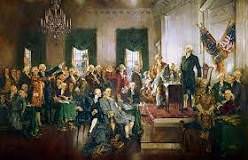
Creating a new government was an immense challenge. The members of the Constitutional Convention all brought their own philosophies and ideas to the meeting at Independence Hall.
The Convention assembled in Philadelphia in May of 1787. The delegates shuttered the windows of the State House and swore secrecy so they could speak freely. Although they had gathered to revise the Articles of Confederation, by mid-June they had decided to completely redesign the government. There was little agreement about what form it would take.
The Great Compromise
At the Convention, several plans were introduced. James Madison's plan, known as the Virginia Plan, was the most important plan. The Virginia Plan was a proposal by Virginia delegates for a bicameral legislative branch.
Prior to the start of the Convention, the Virginian delegates met. Drawing largely from Madison's suggestions, they drafted a plan. In its proposal, both houses of the legislature would be determined proportionately. The lower house would be elected by the people, and the upper house would be elected by the lower house. The executive branch would exist solely to ensure that the will of the legislature was carried out and, therefore, would be selected by the legislature. Since this plan was based on population, it would benefit those states with the largest population (mainly Virginia, New York, Pennsylvania, and Massachusetts).
The Virginia Plan
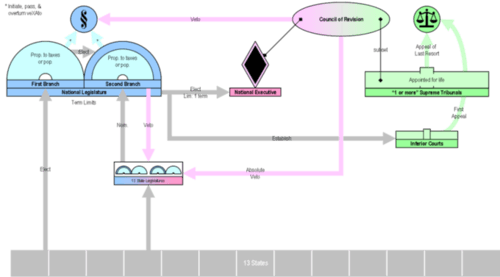
After the Virginia Plan was introduced, New Jersey delegate William Paterson asked for an adjournment to contemplate the plan. Under the Articles of Confederation, each state had equal representation in Congress, exercising one vote each. Paterson's New Jersey Plan was ultimately a rebuttal to the Virginia Plan. Under the New Jersey Plan, the unicameral (one house) legislature with one vote per state was inherited from the Articles of Confederation. This position reflected the belief that the states were independent entities and because they entered the United States of America freely and individually, they remained so. Of course, this plan also benefited the states with smaller populations, and it did not give any consideration to the states with larger populations (like New York, Virginia, Pennsylvania and Massachusetts). As a result, the larger states did not like it.
The New Jersey Plan
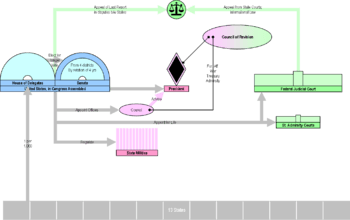
To resolve this stalemate, the Connecticut Compromise, also called the Great Compromise, was forged by Roger Sherman from Connecticut and entered into debate on June 11. In a sense, it blended the Virginia (large-state) and New Jersey (small-state) proposals. Ultimately, however, its main contribution was in determining the apportionment of the Senate and, thus, retaining a federal character in the Constitution. A modified form of this plan was ultimately included in the Constitution.
Slavery

Among the most controversial issues confronting the delegates was that of slavery. Slavery was widespread in the states at the time of the Convention. Twenty-five of the Convention's 55 delegates owned slaves, including all the delegates from Virginia and South Carolina.
Whether slavery was to be regulated under the new Constitution was a matter of such intense conflict between North and South, several Southern states refused to join the Union if slavery was not allowed. Delegates opposed to slavery were forced to yield their demands that slavery practiced within the confines of the new nation be completely outlawed. However, they continued to argue that the Constitution should prohibit the states from participating in the international slave trade, including the importation of new slaves from Africa, and the exportation of slaves to other countries.
The Convention postponed making a final decision on the international slave trade until late in the deliberations due to the contentious nature of the issue. Once the Convention had finished amending the first draft from the Committee of Detail, a new set of unresolved questions were sent to several different committees for resolution.
During the Convention's late July recess, the Committee of Detail inserted language that prohibited the federal government from attempting to ban international slave trading and prohibited imposing taxes on the purchase or sale of slaves. This committee developed a compromise. In exchange for this concession, the federal government's power to regulate foreign commerce would be strengthened by provisions that allowed taxation of slave trades in the international market and provisions that reduced the requirement for passage of navigation acts from two-thirds majorities of both houses of Congress to a simple majority.
The Three-Fifths Compromise
The Three-Fifths Compromise was a compromise between Southern and Northern states reached during the Philadelphia Convention of 1787. It stated three-fifths of the enumerated population of slaves would be counted for representation purposes regarding both the distribution of taxes and the apportionment of the members of the United States House of Representatives. It was proposed by delegates James Wilson and Roger Sherman. This was eventually adopted by the Convention.
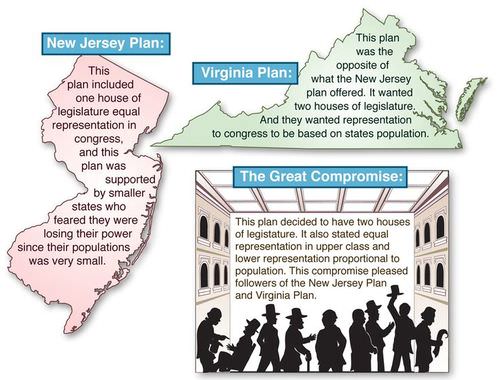
Other compromises dealing with slavery were also made. These included a complete Constitutional ban on debating or passing any new legislation that would end the importation of slaves until at least 1808 (20 years after the ratification of the Constitution). Additionally, a requirement that runaway slaves be returned to the state from which they originated even if they had fled to a free state was included.
Commerce Compromise
Northern interests wanted the government to be able to impose tariffs on goods in order to protect against foreign competition. However, the Southern states feared that tariffs on their goods would hurt the trade upon which they heavily relied. The compromise was to allow tariffs only on imports from foreign countries and not exports from the United States.
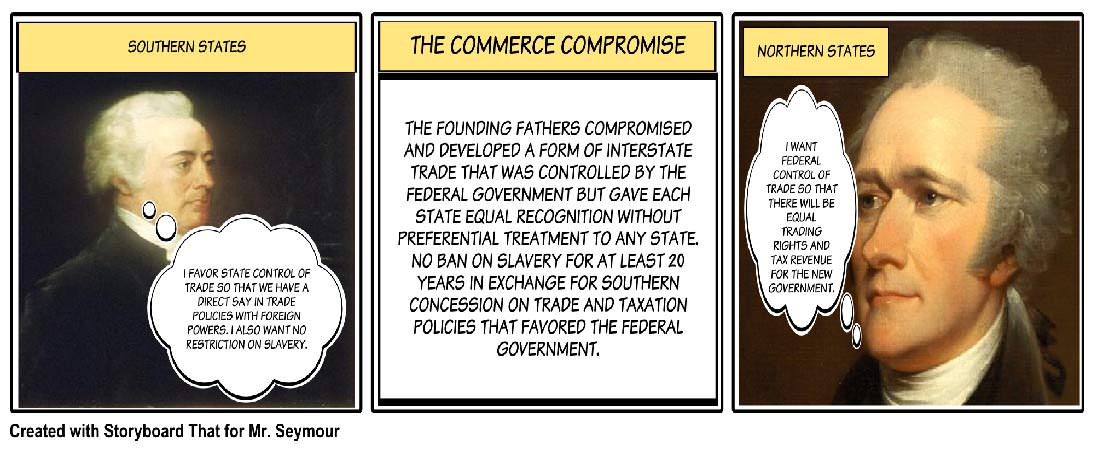
Election of the President
The Articles of Confederation did not provide for a Chief Executive of the United States. Therefore, when delegates decided that a president was necessary, there was a disagreement over how he or she should be elected to office. While some delegates felt that the president should be popularly elected, others feared that the electorate would not be informed enough to make a wise decision. Other alternatives included going through each state's Senate to elect the president. In the end, the two sides compromised with the creation of the Electoral College. Thus, the citizens vote for electors who then vote for the president.
Drafting, Ratification, and Continued Debate
The Constitution was drafted on September 16, 1787. Delaware was the first state to ratify it on December 7, 1787. During the ratification and adoption process, two distinct parties had developed. One party opposed adoption (the Anti-Federalists), and one party favored adoption (the Federalists). These two parties continued to publish justifications for their position in newspapers across the country.
The most famous of these was The Federalist Papers, which promoted the side of the Federalists and argued for the Constitution. After New York ratified the Constitution on July 26, 1788, the Continental Congress was still the official government of the United States (while only meeting at irregular intervals) and passed a resolution on September 13, 1788 to place the new Constitution in operation in eleven states.
The last state to ratify the new Constitution was Rhode Island. Rhode Island was so concerned about this new constitutional form of national government that it failed to even send delegates to the Philadelphia Convention fearing that they "smelled a rat." On May 29, 1790, Rhode Island finally became the 13th state to ratify the Constitution. The result was unanimous ratification by all 13 states.

Study/Discussion Questions
For each of the following terms, write a sentence which uses or describes the term in your own words
|
Great Compromise |
three-fifths compromise |
|
unicameral |
bicameral |
- What was the main goal of the Philadelphia Convention?
- What was the difference between the Virginia Plan and the New Jersey Plan?
- Why was the Three-Fifths Compromise controversial?
- How were the issues over slavery and trade settled?

